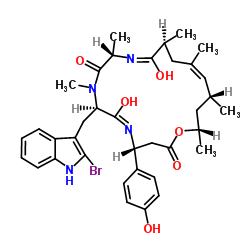Amplification of insulin secretion by acetylcholine or phorbol ester is independent of β-cell microfilaments and distinct from metabolic amplification.
Nizar I Mourad, Myriam Nenquin, Jean-Claude Henquin
Index: Mol. Cell. Endocrinol. 367(1-2) , 11-20, (2013)
Full Text: HTML
Abstract
Insulin secretion (IS) triggered by β-cell [Ca(2+)](c) is amplified by metabolic and receptor-generated signals. Diacylglycerol largely mediates acetylcholine (ACh) effects through protein-kinase C and other effectors, which can be directly activated by phorbol-ester (PMA). Using mouse islets, we investigated the possible role of microfilaments in ACh/PMA-mediated amplification of IS. PMA had no steady-state impact on actin microfilaments. Although ACh slightly augmented and PMA diminished glucose- and tolbutamide-induced increases in β-cell [Ca(2+)](c), both amplified IS in control islets and after microfilament disruption (latrunculin) or stabilization (jasplakinolide). Both phases of IS were larger in response to glucose than tolbutamide, although [Ca(2+)](c) was lower. This difference in secretion, which reflects metabolic amplification, persisted in presence of ACh/PMA and was independent of microfilaments. Amplification of IS by ACh/PMA is thus distinct from metabolic amplification, but both pathways promote acquisition of release competence by insulin granules, which can access exocytotic sites without intervention of microfilaments.Copyright © 2012 Elsevier Ireland Ltd. All rights reserved.
Related Compounds
| Structure | Name/CAS No. | Molecular Formula | Articles |
|---|---|---|---|
 |
Jasplakinolide
CAS:102396-24-7 |
C36H45BrN4O6 |
|
Rapid changes in phospho-MAP/tau epitopes during neuronal st...
2011-01-01 [PLoS ONE 6 , e20878, (2011)] |
|
P2Y2 receptor signaling in neutrophils is regulated from ins...
2015-08-15 [Exp. Cell Res. 336 , 242-52, (2015)] |
|
Actin polymerization controls the activation of multidrug ef...
2012-09-01 [Mol. Biol. Cell 23(18) , 3663-72, (2012)] |
|
F-actin-myosin II inhibitors affect chromaffin granule plasm...
2012-10-01 [J. Mol. Neurosci. 48(2) , 328-38, (2012)] |
|
Endothelial actin depolymerization mediates NADPH oxidase-su...
2014-01-01 [Am. J. Physiol. Heart Circ. Physiol. 306(1) , H69-77, (2014)] |